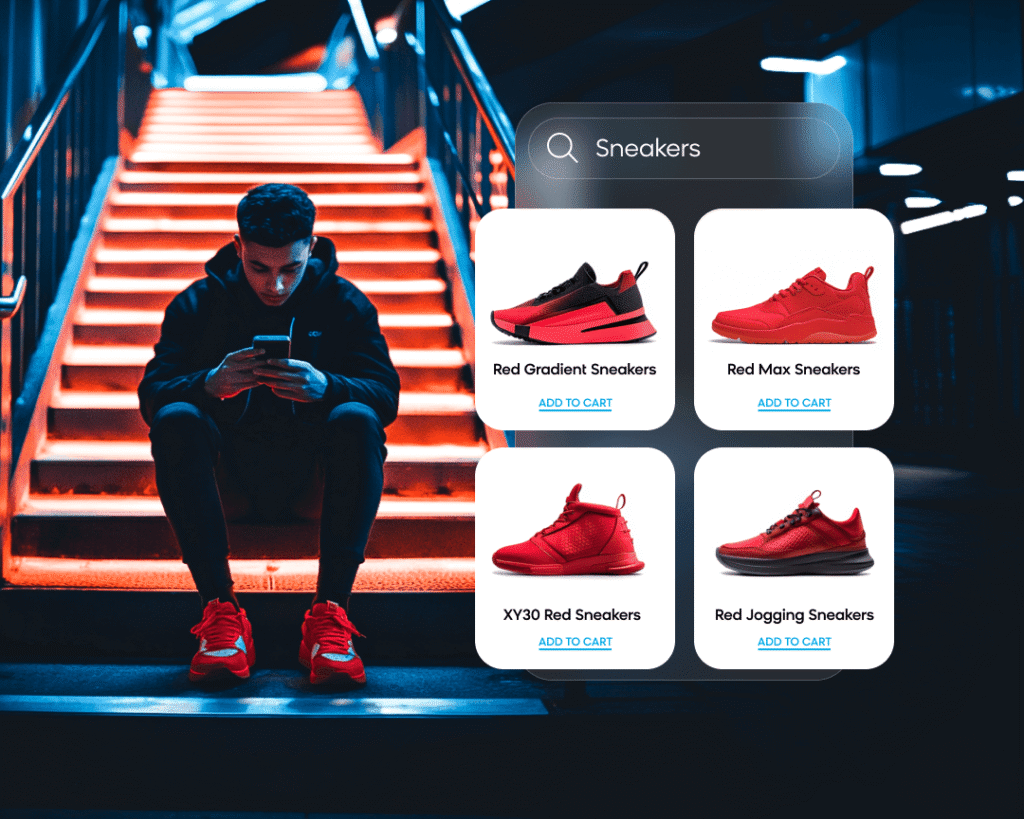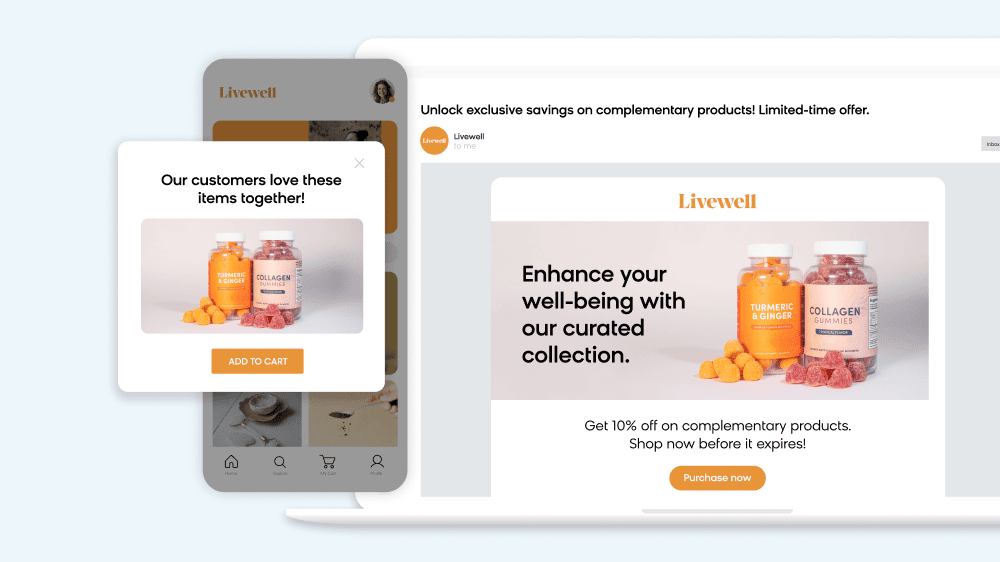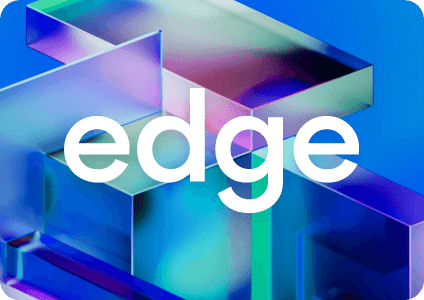Shopping today looks different from what it did 20 years ago. No more spending your weekends in an indoor mall, flitting from store to store in search of a specific item. These days, you can do it all online, scrolling, clicking, and comparing until something stands out.
Just like shopping has changed, so have our search methods. People don’t want to dig through pages of suggestions. They want fast, accurate results that align with what they’re trying to find.
Traditional search relies on exact keywords. If a shopper types in the right phrase, they’ll probably get something useful. This may yield results, but it doesn’t match how people think or help your brand stand out.
AI search works differently. It bridges the gap between what customers want to buy and what they search for. Read on to learn how AI search uncovers what shoppers truly want and outperforms traditional methods across every metric.
What Is AI-Powered Search in Ecommerce?
Forget what you thought you knew about ecommerce search. Artificial intelligence improves everything about site search, helping customers find what they want faster and spend more. Here’s what you need to know.
Definition and Core Technologies
Ever tried searching for something using a keyword, only to end up with completely irrelevant results? Shoppers experience this all the time. Good thing there’s an antidote: AI-powered search.
AI-powered search does more than match keywords. It uses machine learning to track how users behave, getting smarter with every interaction. Natural language processing (NLP) picks up on the meaning behind what customers are searching for. Real-time behavior analysis tracks preferences as they shop, adjusting instantly. Together, these AI tools help ecommerce sites give shoppers results that feel natural and personalized.
Traditional keyword search is rule-based, meaning it only returns results that match the query exactly. But AI search understands nuance. While a typical keyword search for “water bottle” might miss products labeled as “canteens,” AI models recognize the intent behind the query and fill in the blanks with relevant alternatives.
How AI Interprets Intent Beyond Keywords
Now that AI is on the scene, ecommerce brands provide two very different search experiences: one uses outdated technology, and the other uses modern computing to understand and address shoppers’ needs. Can you guess which one meets customer expectations?
Understanding customer sentiment is one of the biggest advantages of AI search. Using tools like natural language processing (NLP), semantic understanding, and conversational AI can translate vague or conversational queries into real results.
With this AI technology, it only takes a few moments to turn an impersonal site search into one that feels more like interacting with virtual assistants.
Where It Fits in the Ecommerce Tech Stack
AI search doesn’t work in a vacuum. It becomes even more powerful when it’s connected to other tools in your tech stack, like your product information management (PIM) system, customer relationship management (CRM) platform, customer data platform (CDP), and merchandising tools.
Consider what happens when AI search taps into your PIM. The AI is now able to understand your catalog on a deeper level, so it can recommend the right variant, color, or size without any guessing. When connected to your CRM and CDP, the AI can personalize results based on a shopper’s loyalty status and purchase history.
Bloomreach is designed to work smoothly with your current systems, so you can enjoy smarter personalization, consistent messaging, and real-time inventory updates. Best of all, you don’t have to micromanage every detail for the system to run perfectly.
How AI Evolves Over Time
One of the coolest aspects of AI search is that it never stops learning, and the AI search you used yesterday won’t be the same one today. Thanks to self-learning models, the AI constantly analyzes new data so it provides the best customer experience at all times.
This means your search experience stays current, even with seasonal product updates or shifting customer trends. AI is always in lockstep with your shopper, reshuffling rankings and uncovering new product relationships in real time.
As you continue using AI systems, you’ll notice that they are more accurate, show fewer no-results pages, and provide customer interactions that feel increasingly personalized. Instead of simply reacting to data, you can anticipate what your customers might need next, placing you head and shoulders above your competition.
Why Understanding Customer Needs Is Critical to Ecommerce Growth
Sure, you need the right products to succeed in your business, but you must also make sure people can find them. To do this, you must understand what your customers are looking for, even if they don’t say so in exact terms.
Let’s explore what goes wrong with traditional search and how a better understanding can improve outcomes on both sides of the shopping cart.
The Cost of Irrelevant Results
When shoppers can’t find what they’re looking for, they leave. Poor search experiences frustrate users, causing them to exit your website and try again with one of your competitors. Your revenue growth goes with them, especially considering 43% of ecommerce experiences begin with search.
If shoppers get irrelevant results, they leave, and 52% take their whole cart with them. If your search results aren’t tuned to the way customers think and speak, they won’t buy and aren’t likely to return.
How Better Search Drives Conversions and Loyalty
Have you ever found something online and thought, “This is exactly what I was looking for”? That’s the kind of experience your brand should aim for.
AI-driven search is a great place to start. It understands what your customer wants and delivers spot-on results, making that “perfect match” moment happen more often. AI search picks up on preferences and patterns, so results feel personal, not random. That leads to higher click-through rates and more conversions.
Remember: relevance matters. If a customer searching for a “vegan leather wallet” is shown a cowhide coin purse, they’ll bounce. But if they find the accessory they have in mind, they’re more likely to buy now and shop again later.
Search as a Source of Behavioral Insight
If the eyes are the window to the soul, search data is a window into what your customers want. Every query reveals preferences, needs, and context you can use to guide how you sell and connect with them.
By analyzing what people search for and how, brands can spot trends, identify product gaps, and mirror the language customers use. For example, if searches for “natural sleep aid” are rising but not earning clicks, it might be time to rethink your descriptions or expand inventory.
Search isn’t just a feature. It’s a real-time feedback loop that helps you refine your site and marketing strategies, so you can better serve your target audience.
How AI Search Understands Customer Intent in Real Time
Every shopper arrives at your site with a different way of asking for what they want. Some are direct. Others are vague. AI-powered search bridges those gaps by interpreting customer signals as they happen, so shoppers get what they’re looking for. Here’s how:
Query Rewriting and NLP
While you may have a deep understanding of your product catalog, your customers most likely do not. Luckily, natural language processing (NLP) can understand what shoppers are looking for using context and past behavior. For example, if someone searches for a “wedding gift for my best friend,” NLP knows they want something personal, like a custom jewelry box, not a simple photo album.
Mobile users are particularly likely to use long-tail or vague queries, since they usually type quickly and imprecisely. Bloomreach’s NLP rewrites these queries in real time to match product data more effectively, so a search for “black waterproof booties no heel” points the shopper toward flat, weather-resistant ankle boots.
Behavioral Signals and Product Affinity
There’s meaning in every click, and AI search helps you catch those signals and use them wisely. Understanding how your shoppers behave on your site, what they look at, and what they buy can help you rank product recommendations in a way that feels natural.
At Bloomreach, we developed an algorithm that understands how to determine a customer’s affinity for certain attributes. Our algorithm learns how to weigh certain affinities based on context and user intent. For example, a customer may have an affinity for green shirts, but if they search for “blue shirt,” then the algorithm knows to let that search intent override their affinity.
Session-Aware Personalization
AI search doesn’t just learn over time. It learns within the session, so you don’t have to delay gratification to improve your sales approach. As a shopper clicks, plays with filters, or lingers on certain products, Bloomreach adjusts rankings and suggestions on the fly.
For example, if someone searches for “yoga accessories,” then clicks on “foam roller” and filters by color, Bloomreach can show related items like matching yoga blocks without the shopper needing to adjust their search. This keeps the shopping flow natural and helps them find exactly what they want more quickly — a key feature of 97% of consumers‘ favorite retail sites, where speed is a priority.
Visual and Contextual Cues
Sometimes, the best clues aren’t in the search box. AI search can also use visual and contextual signals, like image-based queries, device type, or location, to refine results.
For example, if someone searches for a “picnic blanket” on their phone during a summer afternoon, AI search might prioritize lightweight, brightly colored options. But if the search happens on a desktop in the fall, it could highlight thicker, more insulated blankets. Context helps AI search deliver more relevant results in the moment, so your brand experience is more in tune with shoppers’ needs.
Product Enrichment and Synonyms
Your product catalog is the backbone of your ecommerce site. If your catalog isn’t standardized, it can be harder for customers to find what they want. Many brands struggle with this — they use incomplete catalogs or refer to the same products using different names, which messes up search results.
AI can bridge these gaps so your search function doesn’t miss a beat. Bloomreach uses product enrichment models to fill in missing or inconsistent data. It also applies dynamic synonyms, so if a customer searches for “lounge pants,” they’ll still see results for sweatpants and joggers. These tools help you speak your customer’s language, even if your product listing doesn’t.
Ways AI Search Improves Ecommerce Experiences
AI-powered search does more than help shoppers find products — it builds customer loyalty. Let’s look at a few ways AI search benefits customers and businesses.
Faster Product Discovery
Who has time to dig through dozens of irrelevant results? Certainly not your customer. AI search dramatically speeds up the discovery process by surfacing the most relevant products right away. It can even do this when queries are vague, misspelled, or uniquely phrased. This helps shoppers find what they need fast, shortening the time between browsing and buying. Over time, this supports long-term revenue growth.
What if queries turn up zero results? AI has a fix for that, too. Rather than showing an empty page, AI analyzes the query and recommends nearby or related products that still match the shopper’s intent. This turns what used to be a dead end into a new shopping opportunity that encourages customers to keep browsing.
More Relevant Merchandising
Irrelevant merchandising can be a major turn-off for customers. When shoppers keep seeing items that don’t match their needs, it creates frustration and drives them away. Beyond being annoying, this makes your brand seem disconnected from what your customer is looking for.
With AI-powered search, you can highlight high-margin items or seasonal collections without disrupting the user experience. Set priorities, like promoting new arrivals for a limited time, while still letting the algorithm rank products based on what shoppers search for. This way, you hit your business goals without sacrificing customer satisfaction.
Better Filtering and Faceting
Good filters help shoppers narrow down options. Great filters anticipate what matters most to them, making browsing more intuitive.
AI search takes regular filters and makes them smarter. Instead of static options that stay the same for everyone, Bloomreach uses dynamic filters that adjust based on a shopper’s past behavior or what they’re doing in the current session. Someone browsing skincare products might see filters for skin type, concerns like acne or dryness, or ingredients like hyaluronic acid, making it easier to find the right products.
Examples of AI Search Anticipating Customer Needs
What sets AI-powered search apart is its ability to use predictive analytics to guess what shoppers are looking for, sometimes before they’ve even finished typing. Below are a few real-world examples of how AI search tailors results based on evolving shopper needs.
Seasonal Shopping Behavior
As seasons shift, so do shopping priorities. AI search adapts by showing results that match the shopper’s needs for the moment.
Take back-to-school shopping: A search for “school backpack” in August could show different results depending on the shopper’s location and browsing habits. Parents in colder regions may see rainproof products, while those in warmer areas might be shown lighter backpacks. AI can even tailor results by grade level, offering kindergarten essentials for one shopper and college gear for another.
Gift-Giving Patterns
Shopping for gifts can be a challenge when shoppers aren’t sure what they’re looking for. AI search can provide suggestions that turn uncertainty into sales.
Consider broad searches like “anniversary gifts” or “Mother’s Day ideas.” AI search narrows them down by occasion, trends, and seasonality to show curated product sets. It also uses browsing behavior and popular items to refine results in real time, so the shopper comes away with the perfect gift.
Size and Style Preferences
Not all shoppers are looking for the same fit, style, or color. AI tracks these preferences so customers see more of what they want and less of what they don’t.
If a returning customer is into wide-calf boots or big and tall men’s fashion, AI search will prioritize those options at the top of the results. It also adapts to preferences like color, material, or length, cutting down on the need for too many filters. This makes shopping quicker and more customer-centric, ultimately boosting average order value.
New Customer Journeys
Think personalized shopping is only for repeat customers? With AI search, even first-time visitors can enjoy personalized experiences. It works by using broader search trends to guide new customers from their very first interaction.
To make a strong first impression, AI draws on historical data, as well as insights from trending products and popular categories, while adapting to the visitor’s browsing patterns in real time. By the time the customer returns, AI has already set the stage for a bespoke shopping experience.
How To Evaluate Your Current Search Experience
Before you can improve your search experience, you need to understand where it’s falling short. These sections outline how to spot weak areas and proactively improve your data collection.
Red Flags To Watch For
Some patterns make it clear your search experience isn’t working as it should. Watch for:
- High bounce rates on search result pages: Shoppers leave the site after seeing the search results without clicking anything
- Low click-to-purchase rates from search: Users click on a result but don’t end up buying the product
- Lots of zero-results queries: Searches return no products at all
- Shoppers lean hard on filters to find basic products: Users have to apply several filters to see what they expect to find from the beginning
If people are leaving your site without clicking or buying, your search is likely showing them too many dead ends.
Benchmarks and KPIs
You can’t improve what you don’t measure. These numbers can help you spot what’s working, what’s slipping, and where you have room to improve.
- Search conversion rate: The percentage of searches that lead to a purchase
- Search exit rate: How often users leave after searching
- Click-through rate (CTR) on search results: A reflection of relevance and ranking quality
Keep an eye on these numbers over time to catch problems early and make smarter decisions about what to fix or test next.
Heatmaps and Session Replays
Numbers tell one part of the story, but visual tools offer a type of customer feedback you can’t get from surveys. They help you see the difference between how people are expected to use your site and how they actually navigate it.
Platforms like Hotjar or FullStory show heatmaps of where users click, how far they scroll, and where they hesitate, while session replays give you an inside look at the customer journey. These tools help you spot friction, like confusing filters or autocomplete that misses the mark.
Build vs. Buy: Getting Smarter AI Search Faster
Once you’ve audited your current search experience, the next question is how to improve it. Here’s what to consider.
Why Building Your Own Search Is Hard
On paper, building your own search engine sounds like a smart way to stay in control. But in reality, it’s one of the toughest parts of running an ecommerce site.
You’ll need infrastructure that can handle heavy traffic, engineers who know how to work with real-time data, machine learning experts to fine-tune results…and that’s just the technical side. Good search also needs smart merchandising, personal recommendations, and constant updates. For most teams, building from scratch is expensive and time-consuming. This creates the kind of friction that derails even your best-laid plans for intuitive site search.
What To Look For in an AI Search Solution
If you’re shopping around for an AI search provider, focus on features that improve the shopping experience and give you more control, such as:
- Natural language processing: Helps search understand everyday language, not just keywords
- Ranking control: Gives you the ability to adjust which products appear first in search results
- Personalization: Adjusts search results based on individual customer behavior and preferences
- Catalog awareness: Helps your site search understand and use your entire product catalog for the most relevant results
- Integration support: Allows search to seamlessly work with your existing tech stack, like your CMS or PIM
Ultimately, you want to purchase a search function that understands people, not just queries.
How Bloomreach Makes It Easy
Bloomreach helps teams get better search without starting from zero. With Bloomreach, you get fast time-to-value, meaning you can start seeing tangible search improvements quickly. This allows you to deliver better results for your customers right away, while also benefiting from real-time personalization, flexible ranking controls, and tools built for both developers and merchandisers. Business users can adjust results through dashboards and visual rule editors, without having to tap engineering teams for help.
It’s also important to note that not all AI is created equal. Other AI search solutions can tackle only part of the problem, resulting in a product discovery experience that still feels lacking or disjointed. Bloomreach’s autonomous search solution is built with a GenAI core that continuously learns and adapts, so you don’t have to waste time trying to “fix” search challenges and can focus your energy on high-impact strategy.
Bloomreach also fits easily into the rest of your ecommerce setup, so search doesn’t feel like a cheap add-on. It becomes integrated into your site’s overall performance, enhancing customer engagement and team efficiency. Plus, it’s easy to scale as your business grows.
AI Search Isn’t Optional — It’s Essential
Today’s shoppers expect search to work like a conversation: fast, intuitive, and relevant from the very first query. With the power of AI, search can go beyond simple queries and instantly adapt to customer preferences, making the shopping experience smoother and more personal.
Ask yourself: Is your current site search helping customers find what they really want? If the answer is no, it might be time to upgrade.
Smarter search means fewer frustrations and happier customers. Curious what AI search could look like for your site? Learn more about the power of Bloomreach’s autonomous search.













